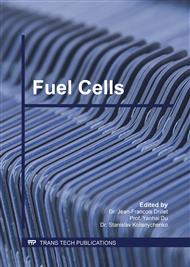p.314
p.323
p.330
p.337
p.342
p.351
p.357
p.367
p.373
Metal-Foam Bipolar Plate for PEM Fuel Cells: Simulations and Preliminary Results
Abstract:
Bipolar plates in Proton Exchange Membrane fuel cells (PEMFC) distribute fuel and oxidant over the reactive sites of the membrane electrode assembly. In a stack, bipolar plates collect current, remove reaction products and manage water. They also separate neighboring cells and keep the oxidant and the fuel from mixing; they provide structural support to the stack. The plates are typically graphite with parallel or serpentine channels. The efficiency of a stack depends on the performance of the bipolar plates, which depends on the material and flow field design. The drawbacks of graphite include weight, fabrication inaccuracy, cost, porosity, and brittleness. Open-cell metal foam is investigated as a flow field/bipolar plate and compared to conventional graphite bipolar plates. The complex internal structure of the foam was modeled using an idealized unit cell based on a body center cube. This cell maintained the actual structural features of the foam. Clones of the idealized cell were virtually connected to each other to form the new bipolar plate. SolidWorks, and Auto-CAD were used to generate the unit cell and the computational domain, which was imported into ANSYS. Meshing of the domain produced than 350,000 elements, and 70,000 nodes. Appropriate boundary and operating conditions for PEMFC were applied, and the PEMFC module within ANSYS was used to obtain the temperature and flow distribution as well as the fuel cell performance. In comparison to conventional bipolar plates, results show that the cell current and voltage densities were improved, and temperature distribution on the membrane was even, and within the allowable limit. As importantly, there was a weight reduction of about 40% as a result of using metal foam as a bipolar plate.
Info:
Periodical:
Pages:
342-350
Citation:
Online since:
October 2018
Authors:
Keywords:
Price:
Сopyright:
© 2018 Trans Tech Publications Ltd. All Rights Reserved
Share:
Citation:



